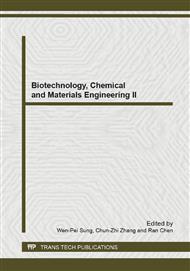p.919
p.923
p.927
p.931
p.935
p.939
p.943
p.947
p.951
Preparation and Properties Analysis of Slow-Release Microcapsules Containing Patchouli Oil
Abstract:
Abstract: The microcapsules containing patchouli oil were prepared using a complex coacervation with chitosan and arabic gum as wall material, patchouli oil as the core material. The different factors influence on the microcapsule properties were investigated by scanning electron microscope, laser particle size analyzer, infrared spectrum and UV spectra. The best conditions for preparing patchouli oil microcapsules were confirmed as follows: the concentration of chitosan with low viscosity 0.5%, arabic gum 4%, and the ratio of wall material to core material was 2: 1. The pH value of the complex coacervation reaction was 4.5, and stirring speed was 800 r/min. The microcapsules were analyzed by Infrared spectral to confirm the patchouli oil had been successfully embedded in the microcapsules. The drug loading and encapsulation efficiency for patchouli was 20.7% and 67.2%, respectively.
Info:
Periodical:
Pages:
935-938
Citation:
Online since:
January 2013
Authors:
Keywords:
Price:
Сopyright:
© 2013 Trans Tech Publications Ltd. All Rights Reserved
Share:
Citation:


